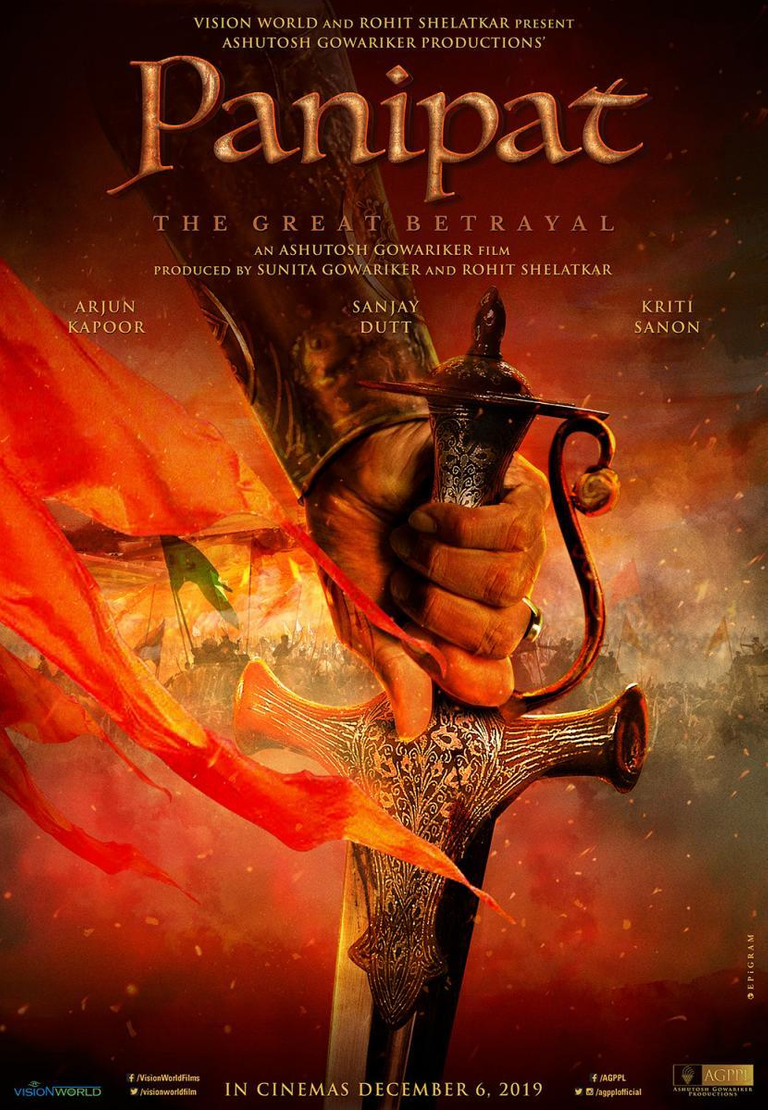Panipat; un derroche de cultura india / Panipat; a splurge of Indian culture

Fuente/ Source

Tres elementos sobresalen en la película Panipat: la arquitectura india enraizada en su historia, cultura y religión. Los paisajes impresionantes que cautivan por la belleza de su naturaleza; y la danza, con el colorido de sus trajes. Las escenas donde el canto y el baile se ven tan deliciosamente cuidadas, impresionan por el número de bailarines y por la magnífica coordinación que dan un ritmo magistral para el deleite de los espectadores.
Three elements stand out in the film Panipat: the indian architecture rooted in its history, culture and religion. The breathtaking landscapes that captivate with the beauty of their nature; and the dance, with the colorful costumes. The scenes where the singing and dancing are so delightfully cared for, impress by the number of dancers and by the magnificent coordination that give a masterful rhythm to the delight of the spectators.
Es una película que recrea un momento histórico en la vida de la India del siglo XVIII. De entrada asumimos que el espectáculo será en una atmósfera de muerte, de las traiciones y las intrigas de la guerra, de heroísmos y sacrificados. Y en efecto, la película trata de la batalla de Panipat; narra las acciones de un comandante maratha que debe crear un ejército para enfrentar a un invasor afgano que amenaza con exterminarlos.
It is a film that recreates a historical moment in the life of India in the XVIII century. From the outset we assume that the spectacle will be in an atmosphere of death, of the betrayals and intrigues of war, of heroism and sacrifice. And indeed, the film is about the battle of Panipat; it narrates the actions of a Maratha commander who must create an army to confront an Afghan invader who threatens to exterminate them.
Fuente/Source
Las escenas de la guerra, por supuesto que son crueles, exaltan a los protagonistas y pintan al campo de batalla con una reguera de muertos; lo que sería normal en una película de este género; pero, antes de llegar a las espadas y a la masacre, están las historias de vida de los hombres que van a morir; su familia, su pueblo, sus miedos.
The war scenes, of course, are cruel, they exalt the protagonists and paint the battlefield with a trail of dead; what would be normal in a film of this genre; but, before getting to the swords and the massacre, there are the life stories of the men who are going to die; their family, their people, their fears.
Y aquí entra Parvati, la protagonista. Debo confesar que su hermosura y lo que significó ella como mujer en la película, fue lo que me llevó a escribir este artículo. Parvati se casa con el comandante, ambos estaban enamorados desde niños (y aquí cumplen el romántico sueño de casarse con el amor de sus vidas). Luego ella decide viajar con él en la arriesgada empresa de crear al ejército; y ahí termina de cautivar.
And here comes Parvati, the main character. I must confess that her beauty and what she meant as a woman in the film, was what led me to write this article. Parvati marries the commander, both were in love since they were children (and here they fulfill the romantic dream of marrying the love of their lives). Then she decides to travel with him in the risky venture of creating the army; and there she ends up captivating.
Fuente/Source
Primero, convence a su esposo para que la deje acompañarlo; segundo, asume la responsabilidad de velar por el cuidado de todos los soldados; tercero, ayuda políticamente convenciendo a otra reina para que apoye la causa de los marathas. Parvati tiene una poderosa presencia en la película e incluso es ella la narradora de los acontecimientos. Me gusta ese personaje que matiza las acciones bélicas, pero cuando le toca alzar la espada no duda en proteger a las otras mujeres y mata para salvarse.
First, she convinces her husband to let her accompany him; second, she assumes the responsibility of seeing to the care of all the soldiers; third, she helps politically by convincing another queen to support the Marathas' cause. Parvati has a powerful presence in the film and is even the narrator of the events. I like her character as a character who shades the warlike actions, but when it is her turn to take up the sword she does not hesitate to protect the other women and kills to save herself.
Es la segunda película que veo de este director, Ashutosh Gowariker, en esta contrasta su escenario bélico, exuberante y épico, con una carga amorosa centrada en la mujer india como complemento del hombre; Parvati no es una simple esposa, es la mujer que apuesta por su reino, por su pueblo y por su marido. La película también sirve para darnos una muestra, bien equilibrada, de las tradiciones de la India, a través de los cantos, el bailes y los trajes dancísticos; aparte de cautivarnos con la arquitectura india.
This is the second film I see of this director, Ashutosh Gowariker, in this one he contrasts his war scenario, exuberant and epic, with a love load centered on the Indian woman as a complement of the man; Parvati is not a simple wife, she is the woman who bets for her kingdom, for her people and for her husband. The film also serves to give us a well-balanced sample of the traditions of India, through the songs, dances and dance costumes; apart from captivating us with the Indian architecture.

https://twitter.com/2199950047/status/1618599200635392000
The rewards earned on this comment will go directly to the people sharing the post on Twitter as long as they are registered with @poshtoken. Sign up at https://hiveposh.com.
@tipu curate 6
Upvoted 👌 (Mana: 0/55) Liquid rewards.